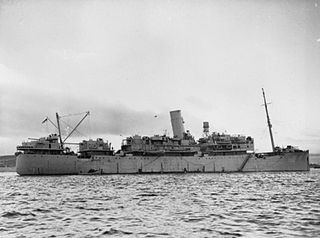
HMS Belfast is a Town-class light cruiser that was built for the Royal Navy. She is now permanently moored as a museum ship on the River Thames in London and is operated by the Imperial War Museum.

HMS Cheshire was a passenger ship that was built in Scotland in 1927 and scrapped in Wales in 1957. She belonged to Bibby Line, which ran passenger and cargo services between Rangoon in Burma and various ports in Great Britain, via the Suez Canal and Gibraltar. The Admiralty requisitioned her in 1939 and had her converted into an armed merchant cruiser (AMC). She was converted into a troopship in 1943, and returned to civilian service in 1948.

RMS Arlanza was a 14,622 GRT ocean liner of the Royal Mail Steam Packet Company. She was built in Belfast in 1912 for RMSP's scheduled route between England and South America. She was a Royal Navy armed merchant cruiser from 1915 until 1920. She returned to civilian liner service in 1920 and was scrapped in 1938.

RMS Alcantara was a Royal Mail Lines ocean liner that was built in Belfast in 1926. She served in the Second World War first as an armed merchant cruiser and then a troop ship. She returned to civilian service in 1948 and was scrapped in 1958.

HMS Rifleman was a turbine-powered Algerine-class minesweeper of the Royal Navy. She was launched in 1943 and saw active service during World War II, both in the European and Far East theatres. After the war she served in the Mediterranean and was used as an accommodation ship in Barrow before being sold for breaking in 1972.

MS Dunnottar Castle was a British-built passenger ship with a career of more than six decades that included periods as an ocean liner, an armed merchant cruiser (AMC), a troop ship and several decades as a cruise ship. As a cruise ship she was renamed Victoria, then The Victoria and finally Princesa Victoria.

MV Reina del Pacifico was a 17,707 GRT ocean liner of the Pacific Steam Navigation Company. She was built in Northern Ireland in 1930–31 and sailed between Liverpool and the Pacific coast of South America until 1939. She served as a troop ship from 1939 until 1946. She returned to her civilian route in 1948 and was scrapped in 1958.

HMS Bryony was a Flower-class corvette that served in the Royal Navy and Royal Norwegian Navy.

SS Pennland was a transatlantic ocean liner that was launched as Pittsburgh in Ireland in 1920 and renamed Pennland in 1926. She had a succession of UK, German and Dutch owners and operators. In 1940 she was converted into a troopship.

SS Westernland was a transatlantic ocean liner that was launched as Regina in Scotland in 1917, renamed Westernland in 1929 and was scrapped in 1947. She began her career as a troop ship repatriating US troops after the Armistice of 11 November 1918. In the Second World War, Westernland served as a troop ship, repair ship and destroyer depot ship.
RMS Andes was a 26,689 GRT steam turbine Royal Mail Ship, ocean liner, cruise ship, and the flagship of the Royal Mail Lines fleet. She was the second Royal Mail ship to be named after the South American Andes mountain range. The first RMS Andes was an A-class liner launched in 1913. In 1929 that RMS Andes was converted into a cruise ship and renamed Atlantis.

RMS Asturias was a Royal Mail Lines ocean liner that was built in Belfast in 1925. She served in the Second World War as an armed merchant cruiser until she was crippled by a torpedo in 1943. She was out of action until 1948 when she returned to civilian service as an emigrant ship. She became a troop ship in 1954 and was scrapped in 1957.

SS Queen of Bermuda was a British turbo-electric ocean liner that belonged to Furness, Withy & Co Ltd. Its Furness Bermuda Line subsidiary operated her between New York and Bermuda before and after the Second World War. During the war she served as first an armed merchant cruiser and then as a troop ship.

MV Ulster Prince was a passenger ferry operated across the Irish Sea by P&O Ferries between 1967 and 1981. She was sold for further service in the Mediterranean and Far East and was scrapped in 2004.
MV Ulster Monarch was a passenger ferry operated across the Irish Sea between 1929 and 1966 apart from wartime service as an infantry landing ship, HMS Ulster Monarch.
MV Ulster Prince was a passenger ferry operated across the Irish Sea between 1929 and 1940. She became a total loss in Greece while a troop ship during WWII.

HMS Alisma was a Flower-class corvette that served in the Royal Navy.

HMS Dunvegan Castle was a UK ocean liner that was converted into an armed merchant cruiser (AMC) in the Second World War. Harland and Wolff built her and her sister ship Dunnottar Castle in Belfast in 1936.

MV Waimarama was a UK refrigerated cargo liner. She was built in Northern Ireland for Shaw, Savill & Albion Line and launched in 1938. She carried perishable foods, particularly meat, from New Zealand to the United Kingdom.

The SS Narkunda was a passenger ship commissioned in 1920 by the British shipping company, Peninsular and Oriental Steam Navigation Company, which carried passengers and mail from Great Britain to Australia and later to the Far East. From 1940 she served as a troop ship until she was sunk on 14 November 1942, on the Algerian coast during a German air raid.

















